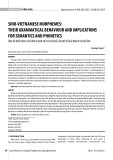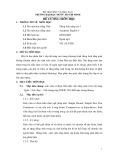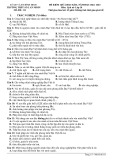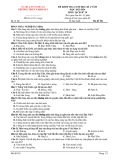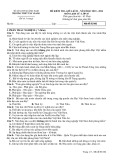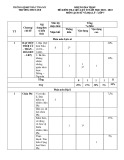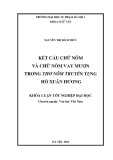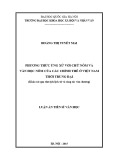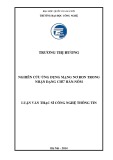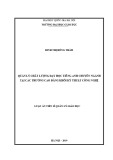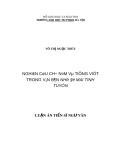VIETNAMESE PERSONAL PRONOUNS
V. U. Nguyen
Study of the Vietnamese language has seldom paid attention to the characteristics and origin of Vietnamese Personal Pronouns. This possibly stemmed from continuing debate as to the origin of the Vietnamese language itself, and the apparent lack of a reliable theoretical framework for the etymology of Vietnamese lexicon, apart from conventional distinction between Sino-Vietnamese words and pure Nôm vocabulary.
Recently, Nguyen [1] proposed a new approach, based on the Tree-and-Soil model, for explaining the evolutionary formation of Vietnamese, closely in rapport with a theory on the origin of the Vietnamese. Under the Tree-and-Soil model, the Vietnamese language is a historical and evolutionary merger of many languages and dialects. It has a Mon-Khmer substratum mixed with Thai and Polynesian, superimposed and interwoven with strata of the ancient Bai Yue (Bách Việt) groups in Southern China, being most notably ancient tongues spoken in Yunnan, GuangXi, Guangdong, Fujian, Zhejiang, Hainan, and later by those of the Hakka and Miao-Yao (Hmong-Mien) groups. And in this paper, Vietnamese personal pronouns will be examined in some detail, using the theory above, and at the same time, relevant results will be used to provide feedback, and to lend further proof, to the theory.
Of all the features of Vietnamese personal pronouns, two stand out as most characteristic, being, one, the pronouns are related to kinship terms or social deference address system, and two, the first personal pronouns in the plural (We / Us) involve both inclusive and exclusive forms, formatted by the use of a plural marker (chúng / tụi / bọn). These two features, as shown in the following, in fact share some commonality with many languages or dialects in the region, postulated by Nguyen [2] as constitutive components of the Vietnamese language in its evolutionary formation.
Some salient characteristics of Vietnamese personal pronouns, with reference to their counterparts in neighboring languages and dialects, seen as constitutive components of the language, will be examined as follows.
1. I and Me
Vietnamese words denoting the first person pronoun are plentiful: Tôi, ta, tớ, tui, tao, mỗ, mình, miềnh, qua, …, together with a range of vocabulary taken directly from the speaker’s own social role in the speech: Anh (elder brother), em (younger brother), chị (elder sister), em (younger sister), chú (uncle), cô / dì
1
(aunt), cháu (grand-son, grand-daughter, nephew / niece), Thầy / Cô (teacher), Bố / Ba (Dad), Mẹ / Má (Mom), Cậu (Uncle / young man), Cô (Young lady), Con (Son /daughter), etc. Consider the first person pronouns in singular form, applicable to both genders, as follows.
Tôi (and Tớ): meaning ‘I / me’, frequently has declension ‘Tui’ especially in the Southern dialect, following a rule in sound correspondence: [u] <=> [ô], as between ‘Kung-Fu’ and Công Phu, Mandarin [Gong] and ‘Cung’ (bow), Cantonese [Ung] and ‘Ông’ (Mister) [27], tòng and tùng (fir, subordination), thúi and thối (smelly), etc.
Many dictionaries, particularly the early ones, such as Alexandre de Rhodes’ Annamite-Portuguese-Latin dictionary [3], often assigned ‘tôi đòi’, or ‘đầy tớ’, or ‘tôi tớ’, meaning servant or maid, as etymons of Tôi and Tớ. This is quite consistent with modern-day pronunciation [Toi] { 儓 } in the Hakka and Cantonese dialects, meaning ‘Servant’. Mandarin pinyin for [toi] is both [tai-2] and [dai-4], showing ‘tôi đòi’, or ‘đầy tớ’, and Mandarin [tai dai] are well connected. In fact, ’Tớ’ has closer sound to Hakka [tsut] or [su] and Cantonese [zeot] or [syu] written as 豎 or 卒 , both meaning ‘servant’. More likely, however, a cognate of ’Tớ’ can be found in the Hmong language as [Tub] where ‘b’ is a rising tone marker, similar to the Vietnamese Sắc accent in ’Tớ’. Under the Tay-Nung dialect, “Khỏi” is equivalent to ‘Tôi” with both meanings: I/Me and Servant.
The Alexandre de Rhodes dictionary gave a remark about ‘Tớ’ being normally used in an angry mood: ‘Tớ đã làm chi ngươi’ = I have not done anything to you – where ‘ngươi’ refers to ‘You’ with a social or kinship rank lower than that of the speaker, Tớ, who is in an angry mood.
Present-day Cantonese has the word [tseoi] 余, being likely a cognate of ‘Tôi’, reserved for ‘I’ or ‘Me’ in formal speech. Its pronunciation in the Hakka and Wu dialects is [Y] {[I]}, which is similar to the phoneme for the third person pronoun, in Chinese as well as Vietnamese (see Table I, below). ‘Tôi’ can also be found in the Mường dialect using an aspirated initial ‘T’, as ‘Thôi’.
Mỗ: Rarely used nowadays for the first singular personal pronoun. It could be related to [mau] in Cantonese. Huình Tịnh Paulus Của’s dictionary [4] listed it as 某 [mou] with meaning ‘tôi (I), min (me), tên nọ, tên kia (that person), (chỉ trống) (some / certain)’. Mandarin sound is [mou] meaning ‘certain, some’. Chinese compound word [mo lian] 磨 练 , with [mo] very close to [mỗ] in sound, meaning ‘to forge (steel)’ or ‘to temper’, often ‘translated’ into Vietnamese as ‘tôi luyện’, shows that at some time in the past ‘Mỗ’ and ‘Tôi’ were interchangeable. It is of interest to note that many word sounds re- constructed in the 20th century gave [ma luyện] as the ‘official’ Hán-Việt (Sino-
2
Vietnamese) equivalent of Chinese [mo lian], possibly unaware of the ‘relation’ between ‘Mỗ’ and ‘Tôi’. Under the topic of ‘similarities over long distance’ [2], it can be seen also that Mỗ is close to French ‘Moi’.
Mình: In Mường and in some parts of Central Vietnam, Mình is pronounced as [Miềnh]. In the 17th century it was [Mềnh] or [Min] [3]. Mình is close to Hakka
[mi] 微, Cantonese [mei], and English [me]. Essentially it refers to one’s own
body (thân mình) [23]. Its usage varied with time. In the Alexandre de Rhodes dictionary [3], it was said to be used when the speaker is of a higher social or kinship rank.
In modern usage, it seems Mình is used among people of close relationship. Sometimes it can be used as the second personal pronoun: Mình ơi, mình ở đâu = Darling, where are you?
Etymologically also, Mình is related to [Ming] and [*minqu] in Mon-Khmer.
Ta (and Tao): Very likely both ‘Ta’ and ‘Tao’ have strong link with the Mon- Khmer variety. Burmese words for ‘I / me’ are [Tjano] and [Tjama] depending on the gender of the speaker. [Tja] in [Tjano] and [Tjama] is very close to Vietnamese ‘Ta’. The main Champa word for the first person pronoun is [Tahlă’]. Likewise, ‘Ta’ has a straight sound correspondence with [Tsa] 咱 in Hakka, and [Zaa] in Cantonese, [Sa] 洒 in Fujian, and [Saa] in Cantonese [5], all meaning ‘I’ or ‘me’. In a sub-dialect of Cantonese, [Zaa] 咱 can be pronounced as [gau] which corresponds to the Tay-Nung sound for ‘Ta’ or ‘Tao’: [Câu], Boong Câu = Bọn Tao (we /us).
According to Hayes [6], ‘tao’ is closely related to Mon-Khmer [saqu]. It is also possible that ‘Tao’ is a derivationally combined sound between ‘Ta’ (or Tôi) and Polynesian word ‘Au’ for ‘I / me’ (see Table I).
Qua: ‘Qua’ is perhaps the least understood pronoun in Vietnamese, as it is often mistaken as a peculiar word of the Southern dialect. In fact it has many cognates separated over long distance. First, the Mường dialect has similar word ‘Qua’ or ‘Wa’ for the first personal pronouns ‘I / We’, though more frequently used for ‘We / us’. Similarly, [gua] is a Fujian / Hainan word for ‘I / Me’. The Japanese language seems to combine both ‘Wa’ and ‘Ta’ into one word for the first person pronoun: Watashi. And ‘Qua’ has a number of cognates in Mon-Khmer dialects [6]: *aku, *nqua, *iqua, *inquan, etc.
One relatively popular first person pronoun in Vietnamese is ‘Anh’ normally reserved for speaker being an elder brother or older male, seems to be cognately related to [?ənh] or [ănh] or [?inh] in Mon-Khmer, meaning ‘I / me’,
3
[enh] in Mường, and ‘Ani’ in Japanese, and from afar, ‘aîné’ in French.
In Mường, the most popular word for ‘I / Me’ is [Ho], which has [Hou] 予 in Fujian, [Hây] in Tày-Nùng as cognates. Mường [Ho] also has similar sound to Cantonese [o] which is a sub-dialect pronunciation of [ngo] 我 , being the ‘official’ Chinese word [Wo] for ‘I / me’ [15]. ‘O’ in Vietnamese with meaning ‘bà cô’ (aunt) could be an innovation related to Cantonese [o] above.
Pronoun for the interrogative ‘AI’, equivalent to ‘Who’ in English, was discussed in [1] & [2]. Basically, ‘Ai’ has an alternative pronunciation [Ngai], in the Hakka dialect, meaning ‘I / me’, having sound similarity to many other languages in the region: [AI] in the Mạ ethnic group in Central Vietnam, and the Kha group along the Laos-Vietnam border, [Atashi] in Japanese (optional for female), [Aku] in the Malay language, [Au] in the Polynesian languages: Maori, Tahiti and Fiji. The alternative [Ngai] in Hakka, appears to undergo a metaphorical shift to the second pronoun ‘You’ attaching ‘respect’, like ‘Your Excellency’ in English. Similar sound to [Ngai] in a good number of dialects including Mường, is equivalent to ‘Người’, used to denote ‘person’ or ‘human being’ [19].
2. You
The second person pronouns in Vietnamese illustrate strong cultural influence in kinship and social deference address system, quite similar to the Mon-Khmer and many other languages in the region. Like the first person pronoun ‘I / me’, the second pronoun, can take on any noun describing a person’s kinship or social role with respect to the speaker, as mentioned above: Anh (elder brother), Em (younger brother/ sister), Ông (Mister), Bà (Madam), Cô(Aunt), Chú (Uncle), ông Nội (paternal grandpa), bà Ngoại (maternal grandma) [8], etc.
Gilbert and Hang [7], showed a total of 17 different words used for ‘You’ in the Khmer language, depending on kinship and social standing. Among the range of lexicon for ‘You’, [bpaa] (‘Cha’ in Vietnamese) and [bpuu] (‘Chú’) showed striking similarity with Vietnamese counterparts, in meaning as well as in metaphorology [2]. [Bpaa] means Father (Cha), and [Bpuu] (Chú) means ‘Uncle’ in the wide sense, meaning a male (related or not) nearly as old as the speaker’s father.
Father’s elder brother in Vietnamese is called ‘Bác’, which could be metaphorically generated by ‘Ba’ (father). The same can be said between Cha (father) and Chú (uncle: father’s younger brother), or [Bpaa] and [Bpuu] in Khmer, respectively. Note that both Bác (Uncle: father’s elder brother) and Cậu (maternal brother) have almost identical cognates in Cantonese: [Baak] and [Kau], whereas ‘Chú’ (father’s younger brother) appears to be a combined
4
sound of Cambodian [Bpuu], Fujian [chek] and Mandarin [shu] 叔 (‘Thúc’ in Sino-Vietnamese, and [suk] in Cantonese and Hakka). Chú’s wife is called ‘Thím’ being sound correspondence of Hakka [tsim] and Minnan [chim] 嬸. ‘Cô’ (father’s sister) also has etymon in Wu [ku] or Fujian [kou] {姑}, while ‘Dì’ (mother’s sister) was sourced from Mandarin, Hakka, Cantonese [yi] 姨, and Fujian [I]. Maternal brother’s wife, ‘Mợ’, has cognate in [kau-mou] [26].
Vietnamese kinship and social deference address forms for the second personal pronouns also bear some resemblance with pronouns in Cantonese as well as Mường. One exception is Cantonese [Nei] (Ni) or Mường [Da], widely used as second personal pronoun, for anybody, from younger to older, lower to higher social rank: Da ti no? Mày đi đâu: Where are you going? Da ăn chi? Anh ăn gì? [9]: What would you eat?. ‘Da’ however, may indicate some shift in lexical role when considering Hakka [za] for first [24] and third person pronoun, and Vietnamese [ya] for third personal pronoun (See Table I). Like [nong] 儂 in Chinese for ‘I / me’, or ‘he /she’, and ‘You’ in the Shanghai / Wu dialects, [Da] or [za] or [ya] shift among the first, second, and third personal pronoun can be ascribed to some kind of transfer in metaphorical field, often found in languages during formative stage, involving intensive mixing of dialects or languages of different ethnic groups [10].
Perhaps the most common forms of address for “You”, incorporating respect, in Vietnamese are “Ông” (Mister) and Bà (Madam/ Missus / Mrs). Ông, with two common meanings: Mister and Grandpa, has cognates in Thai [Ong] for addressing holy personage, king, and monk, and in Champa [Ông]. Similarly for [Ù] in Burmese. Bà, on the other hand, is likely derived from, or related to a range of lexicon in the region referring to Mother, elderly lady, or address term with respect for a female, such as [iBu] (Indonesian), [poo ying] Thai, [Ba] Burmese, [Bawng] Khmer, and a large number of Southern Chinese dialects with sound around [Pu] or [Bu], or most commonly, [Bo] (i.e. [lao bo] for Wife).
Ancient Vietnamese had a somewhat ‘gender-neutral’ pronoun [Bạu] [3] which has long declined into ‘bậu bạn’ or simply ‘bạn’, literally meaning ‘friend’, nowadays used to address friend or acquaintance, not much older or younger. Bạn in fact is related to Khmer [bouung], and Cantonese [pang] 朋 . A compound word for ‘You’ is ‘anh em’ (as in ‘người anh em’), being a direct equivalent of Chinese [xiong di] (huynh đệ), literally: older-or-younger brother [8]. Another ‘You’-word, used to call a person of ‘lower’ social rank is ‘Mày’ which could be linked with ‘Bây’ (Bay in [3]), as both initial [M] and [B] are bilabial. Alexandre de Rhodes’ dictionary [3] remarked that ‘Bay’ is not as preferable as ‘Anh em’. ‘Mày’ is very close to ‘Mi’, which could be another metaphorical transfer from Hakka [Mi] or Vietnamese [Min / Mình] denoting the first person ‘Me’ (see Table I).
5
EM, meaning ‘younger male / female’, ‘younger brother / sister’ [21], has close sound correspondence with Mường ‘Ủn’, and Japanese ‘Imoto’ (younger sister). ‘Em’ could also be metaphorically related to ‘Enh’ (Mường) denoting ‘elder male’, or [?ənh] in Mon-Khmer. In meaning, ‘Em’ was derived from ‘baby’ (em bé) or ‘young’, corresponding to Thai word [awn]. ‘Em’ also has a cognate in Minnan (Fujian) [eN], Sino-Japanese [ei], and Mandarin [er] [5] [11] [25]. Chị, elder female or sister, has etymons in [*tsi] or [*ci(q)] or [*ji(q)] in Mon-Khmer [6], and [tsi] in Wu, [chia] or [che] in Minnan (Fujian) [5].
3. He, She, Him, Her, and It
The third singular personal pronoun ‘He, She, Him, Her and It’ illustrates the contributory feature of different dialects or languages in the formation of Vietnamese.
As noted by Nguyen [2], wide range of thesaurus of a certain word, or presence of compound words in a mono-syllabic language like Vietnamese, may constitute strong manifestation of ethnic and tongue mixing in the past. Illustrative examples about wide range of thesaurus include verbs like: ‘To throw’ and ‘To carry’. ‘To throw’ or ‘to cast’ can be translated into at least 8 different Vietnamese verbs: Ném, Liệng, Quăng, Chọi, Đôi, Thảy, Vứt, Phóng, …each shown to be linked with a different language or dialect in the region [2]. ‘To carry’ or ‘to bring’, when carried over to Vietnamese, will involve no less than 30 different translations: ẵm, bồng, bế, mang, đem, chở, đèo, tải, vác, khuân, khiêng, xách, kèm, chuyển-vận, chuyên-chở, đeo, cầm, dẫn, đái (đới), đảm, công kênh, ôm, cõng, quảy, gánh, bê, độ, cáng-đáng, tha, bưng, mang, đội, kẹp, etc., which could be grouped into different linguistic sources. Compound words are quite common, combining 2 separate words of the same meaning, each sourced from different tongues: đường xá, chín muồi, thân thể, thẳng tắp, chia sẻ, tâm địa, chậm trễ, etc. For illustration, consider đường xá (road) and chín muồi (ripe). In đường xá, the first word (đường) was derived from Cantonese [dou] and [dung], whilst the second (xá) has cognate in Fijian [sala] and Champa [salan]. Chín in chín muồi (ripe) could be a combined sound of Champa [drih], Cantonese [tsing], and Minnan (Fujian) [chheN]. The latter two [tsing] and [chheN] however seemed to involve a metaphorical transfer or shift in meaning, from ‘green’ (unripe). Muồi on the other hand likely came from Burmese [hmède] and Tongan [momoho], also interestingly related to French ‘mûr’, and Tamil [mudirnda].
The feature of contributory lexicon from different dialects or tongues, as described above, is reflected extensively in the third personal pronouns.
Vietnamese third personal pronoun in general does not have gender distinction,
6
though more words, by habit, are used to denote the male: Hắn, kẻ, gã, y, va (ya). However, when coupled with the demonstrative ‘this’ or ‘that’, the noun used will assign gender to the third personal pronoun. For example: Ông kia (that man), Cô ấy (that young lady), Bà nầy (this lady), or Anh nọ (that young man) in which kia, ấy, nầy and nọ, are demonstratives.
The most common Vietnamese singular third ‘personal’ pronoun is perhaps: Nó, applicable to both genders, as well as animals, birds, and fish.
Nó has cognates in Mường [Nả], Hmong [Nws] {pronounced as [Neu]}, Tongan [Ne], and [Nong] in Chinese, which can be ‘I / me’ or ‘He / she / him / her’, or ‘you’ in the Shanghai dialect. The P’u-Noi, an ethnic minority living near the Vietnam-Laos border, also denote ‘You’ by [No] [2], similar to Shanghai [Nong], and identical to Vietnamese ‘Nó’ for the third person.
Hắn may involve a sense of dislike or derision. ‘Hắn’ could come from
Cantonese [Hang] 牼 , meaning ‘a man’. [Hang] has close connection with
some dialect pronunciation in Vietnam of ‘Hắn‘ as [Héng]. Hắn is also very close to Cantonese [Heoi] which is also related to the third person pronoun in the plural ‘Họ’. The Mường on the other hand use ‘Ho’ (without the Nặng- Tone) [16] as the first personal pronoun ‘I / me’. A popular Mường pronoun for the third person is ‘Lũ’, being shifted to describe ‘They / them’ in Vietnamese, equivalent to ‘Bọn / Chúng’. ‘Lũ’ also has sound correspondence with the Wu
pronoun 娌 for ‘He /She’, pronounced in Cantonese as [lei] [5]. Over long
distance (see [1]), ‘Lũ’ evokes a similar sound in French: ‘lui’, whereas ‘Y’ (see below) and Hắn (or Cantonese [heoi]), have similarity with French ‘Il’ and English ‘He / Him’.
Kẻ and Gã have similar sound correspondence [Ke] and [Goat] in the Cambodian (Khmer) language, and cognates in Cantonese [Kei], [Keoi] and
[Gei] ( 其 渠 ). ‘Kẻ’ with metaphorical shift, also appears to be related to
Hmong [Koj] (2nd person) and Champa [kow] (1st person). Over long distance, Kẻ, pronounced as Ké in Mường, has similar sound correspondence in Rapanui [Ko ia] and Fijian [O KOya], also involving another 3rd pronoun ‘Ya’. Kẻ and Gã are often used with demonstratives: Kẻ ấy, Gã đó. The Mường equivalent to demonstrative ấy, or particularly đấy, is [đỉ]: Ông đấy (V)=> Ông đỉ (M); Bà ấy (V)=> Mễ đỉ (M), noting that the Sắc-tone in Vietnamese normally corresponds to Hỏi-tone in Mường: đấy=> đỉ (that), tiếng (V)=> thiểng (M) (language/ speech); Nó=> Nả (he / she); Chúng=> Chủng (they); đột phá=> đôt phả (original). Sắc-tone in Vietnamese may also correspond to Hỏi-tone in Tày- Nùng: đỏ chói (strong red) => ‘đeng chỏi’ (T-N), chúng (a group) => chủng (T-
7
N). Y and Va {pronounced: [Ya]}, probably more familiar in the Southern dialect, have sound correspondence to a number of languages in the region. Y is derived
from 伊, Mandarin [yi], Hakka [Y], Fujian [I], Hainan [Ee], and Sino-Korean
[I]. ‘Y’ also has corresponding sound in Mon-Khmer: [I]. ‘Y’ via Chinese can also refer to ‘ấy’ meaning ‘that’. ‘Va’ is in itself a quốc-ngữ mis-spelling,
purporting to unify the three initials [W], [V] and [Y] (or [By] {[b ]}) among
the main constitutive ‘dialects’ of Vietnamese, into one [V]. The fact that ‘Bya’ is more familiar in the Southern dialect speaks for its initial sound being [Ya] or
[Bya] ([b a]). The pronunciation [Ya] or [b a], for the third person pronoun,
thence would easily concur with: Hakka [za], Malay [Dia] or [Ia], Tagalog [niya], Sinhalese [Eya], and Polynesian [Ia].
[Ta] 他 the most common Chinese pronoun for ‘He / She’, does not reflect in
Vietnamese, other than ‘Tha Nhân’ (other people), with ‘Tha’ often mistaken as a Sino-Vietnamese word, but in fact a Fujian pronunciation [tha], or a Wu corresponding sound [Tha], for [ta]. The Tay-Nung dialect has [Te] [14] [15], derived from [Ta] for ‘He / She’.
Cái, Kia, Ấy, Nầy, Nọ, Nớ, with Cái normally known in Vietnamese as a counting article or classifier [13]: 1 cái bàn (one table), 6 cái ghế (six chairs), and the rest as demonstratives, used to make up third person pronoun by preceding a noun. Often ‘Cái’ is thought as a Nôm-word borrowed from Sino- Vietnamese ‘Cá’ coming from Mandarin [Ge] 個 . But in fact, both ‘Cá’ and ‘Cái’ have identical sounds in Hakka: [Ka] and [Kai], corresponding to Mandarin [Ge], and Sino-Korean [Kay] [5], being a counting adjunct to demonstrative ‘this’ (này, ni) or ‘that’ (nọ, kia, ấy).
Demonstratives Kia, Ấy, Nầy, Ni, Nọ, Nớ, etc. all have sound correspondence with Southern Chinese dialects. Kia comes very close to Hakka [kia] 其 – which is the same character for Kẻ and Gã (He / She). Ấy corresponds to ‘Y’ 伊, with meaning as both ‘that’ and ‘he / she’ (Ấy equivalent to Ái in Tay-Nung [15] [18]). Ấy also has a Mon-Khmer sound cognate: [?a:y]. Nầy, Ni, Nọ, Nớ, etc correspond to a wide range of Chinese sounds and characters meaning ‘this’ and ‘that’. For example: 呢 Hakka [ni] & Cantonese [nei] (this), 那 Hakka & Cantonese [no], [naa] {that}. “Nầy (Ni)” and “Nọ (Nớ)” also correspond to Cambodian [nih] (this) and [nuh] (that), respectively.
TABLE I: Personal Pronouns (Singular)
8
Languages
I / me
You
NOTES
Vietnamese
Personal names can be used in place of pronouns
He/She/Him /Her/It Nó, cô ấy, anh ấy, hắn, kẻ đó, gã, Y, va (ya), …
Tôi, tớ, tui, mỗ, ta, tao, mình, qua, em, anh, chú, bác, …
Anh, chị, mầy, mi, cô, chú,bác,ông, bà, Cụ, …
Mường
Ho, qua, ha, thôi Da, Enh, ủn,
Mon-Khmer: ?anh (anh), saqu (tao), nqua (qua), min (mình) Ha = ta; Miềnh = mình;
ông, etc.
Nả, lũ, enh đỉ, ông đỉ, mễ đỉ, …
ủn= em; đỉ= đó; enh=anh Noọng= young girl, hô=guy Tahlă’ => ta
Nhu Kubun,kunyo, ku Gu-saram: that person Koj ~ keoi (Cant) 3rd pers. Nws [neu]* Ta, zih, zu, ix, za Chit{Hakka}~Cháu(Viet)
Tày-Nùng Champa Korean Hmong Hakka
Hây, Câu, noọng mầu, pỉ, chai Te, mền, ... Kow, tahlă’ Nae,na,che, cho Kuv Mi, ngai, ai, chit, sa, za, tsa
Hư Dangsin,no Koj * Ni, ngi, li, gwi, nai
Ta, tuo, zhi
Mandarin Cantonese
Za => ta. Mi => Mình TA: Tha nhân= other people Tseoi => tôi
Ni, nin Nei, lei, joek Ta, zi, kei, keoi, heoi
Wo, yu,… Ngoh, mau, o, mei, jyu, tseoi, zaa, gau
Fujian
Tha, chi, I [ee]
Zăa = you+me / me => ta Gau => câu (Tay-Nung) Sa ~ ta. Gua ~ qua
Sa, gua, hok, hou, bi
Ni,kui, joa, Li
Gua Man Ma Cănaw, Tjano(M)
Y [ee] U Yeh, voh* Thu / thu
Hainan Persian Hindi Burmese
[Bi] => [Mi] / bỉ nhân (me) Y ~ He (English), Il (French) ~ means ‘Similar’ *yeh/voh= this, that title, kinship, occupation
Du Shoma Aap K’ămyà(M) shin (F)
Cămá, Tjama (F) Chan Kh’nhom Saya
/
Khao/Thur/Mun Goat, ke Dia, ia
‘Ya’ (Polynesian,
Thai Khmer Malay Indonesian Rapanui Fiji Samoa Tonga Tahiti Tagalog
Ko au Au, u A’u / ‘ou Au, ku, u Au / vau Ako, ko, sa akin
tjano => ta Khao ~ keoi (Cant) 3rd pers. Variety of ‘YOU’ address ‘Ia’, Tagalog) ~ Viet [ya] {va}. ‘Ko ia’ ~ Fijian ‘o koya’ Au ~ ai Hakka, ai Viet. Ia (Samoa) ~ ya (Viet) Ia (Tonga) ~ ya (Viet) Au ~ Hakka / Viet ‘Ai’ (ni)ya / (kani)ya ~ ya (Viet)
Khun Nek, boong Anda,kamu suadara Ko koe Iko ‘oe / ‘e Ke, koe ‘oe Ka, mo, sa iyo, ikaw
Ko ia O koya ‘o ia Ne, ia ‘oia / ‘ona Siya, niya, sa kaniya
• ~ means ‘equivalent’ or ‘close to’ • Koj => keoi (Cantonese) => Kẻ / Gã (Vietnamese) – Nws => Nó (He / She) • Ta => other people => Tha nhân (người khác) •
In many languages, such as Hindi, second or third person pronouns are formed by placing ‘This / That’ (yeh / voh) in front of a noun.
TABLE II: Personal Pronouns (Plural) Languages We {Incl.}
We {Excl.}
You
They /them
Notes
9
Vietnamese
Các anh/ chị,
Chúng ta, tụi mình, bọn mình
/ /
Chúng bây, quý
Chúng tôi, hai đứa tôi, bọn này, …
Chúng nó, họ, bọn ấy, bọn nó, đám đó, các cô ấy,…
Kinship address title
Tàn=chúng
Mường
Tàn miềnh, tàn ha
Qua, chủng thôi
ông,… Tàn pay, chủng ỗi, chủng da
Tàn nả, hõ, tàn lũ, pẫu
Ha=ta Boong=Bọn Oy’: nàng
Tày-Nùng Champa
Boong Hây (Khỏi) Khol ita, khol trey
Boong Câu Khol tahlă’ [20]
Boong Mầu Oy’ [ụơk]
Boong Te Khol nhu [20]
(darling) No 3rd pers.
Korean
Chúng ta (V) Uri, uri ga
Uri
Dangsin, nohidul Gu-saram,gu-got,
kudul
Pronouns Nej ~ Ni Za ~ ta Men: plural No inc/exc
Hmong Hakka Mandarin Cantonese Fujian Hainan
Peb / ob (2) leeg Zam, za Zan-men,Wo-men Ngoh-deih Lan Gua-mui
Nej, neb (2) Ngai-teu Wo-men Ngoh-deih Gun Gua-mui
Nej, neb (2) Ixtngix Ni-men Neih-deih Lin Du-mui
Lawv, nkawd (2) Zu, zhi Ta-men Keui-deih ?In Y-mui (ee-mui)
Persian Hindi
Ma Ham
Ma Aap
Shoma Ye, ve
Burmese
Ishan Ye / ve= these, those Thu, thu-dó
NO in/exc. distinction Ma ~ man these/those =>pronouns [dó] plural marker
‘You’ [7] Kita ~ ta
Thai Khmer Malay
Cănaw-dó(M), cămá-dó (F) Pouk Rao Yaeng Kita
Cănaw-dó(M), cămá-dó (F) Rao Yaeng Kami
Pouk Khao Gee, puak gee Mereka
Rapanui Fiji
Ko taua Da, datou, daru (2)
Ko ra’ua Ra, ratou, rau
Taua ~ ta Clear on in/ exclusive (2):dual (2):dual
Samoa Tonga
K’ămyà-dó(M), shin-dó (F) Pouk Khun Awh lowk Saudara (kamu)sekalian Ko korua O ni, o dou, o drau (2) ‘Outou,‘oulua(2) Mou,kimoutolu
Kinautolu,
Tatou, ta’ua(2) Mau, kimautolu, ma / kimaua (2)
Ko maua Keimami, keitou,keirau (2) Matou,ma’ua(2) Tau,kitautolu, ta / kitaua (2)
Latou, la’ua(2) Nau. na / kinaua (2)
Tau ~ tao Tatou ~ ta Tayo ~ ta
Tahiti Tagalog
Tatou, taua Tayo, sa atin
Matou, maua Kami, sa amin
Mo/ kimoua (2) ‘outou, ‘orua Kayo, sa inyo
Ratou, raua (2) Sila, sa kanila
• In Hindi, ‘these / those’ (ye / ve) are used to form Plural Personal Pronouns • Polynesian languages favour further distinction in the Plural of 2 people
(marked (2) in the Table), as in Vietnamese: hai đứa mình (tôi), hai ta, ...
• Mớ tôi / Mớ qua [3] [4] => wo-men => We. Mớ ~ [Mui] (Hainan) ~ [Men] (Mandarin). In Mandarin, inclusive & exclusive distinction for ‘We / Us’ is more pronounced in the North.
4. Personal Pronouns in the Plural
General rule for making Vietnamese personal pronouns in the Plural, is to attach a plural marker (Chúng, Các, Bọn, etc) to their counterparts in the Singular:
- Tôi (I / me) => Chúng Tôi, Bọn Tôi, Tụi Tôi, etc. (We / us) - Anh, Chị, Bạn, Ông, Bà, Bác, Cô, Cậu (You) => Các Anh, Các Chị,
10
Các Bạn, Các Ông (or Quý Ông), Các Bà (or Quý Bà), Các Bác, Các Cô, Các Cậu, etc. (You – plural).
- Nó, Cô ấy, etc (He / she / him / her) => Chúng Nó, Các Cô ấy,... (They/
them)
Most plural markers have origin in Chinese dialects:
(a) Quý customarily used for the second person pronoun, to show respect. Originally Quý means ‘esteemed’ or ‘honorable’, with Chinese character 貴 pronounced as [gwi] or [kwui] in Hakka, [kui] in Fujian, and [kwi] in Sino-Korean.
(b) Các 各 , also reserved almost exclusively for the second personal pronoun, denotes ‘many’ or ‘every’ or ‘all’. ‘Các’ has almost identical sound correspondence in Hakka and Fujian: [kok].
(c) Bọn 幫 , meaning ‘a group’ came from Cantonese [bong] 幫 or [baan] 班. Bọn has strong correspondence with Tày-Nùng [Boong], also used for personal pronouns in the plural [17]: Boong Hây= Chúng ta (We); Boong Câu= Chúng Tao (We); Boong Mầu= Chúng mày (You); Boong Te= Boong Mền= Chúng Nó (They).
(d) Tụi 隊 has identical pronunciation in Hakka [tui] meaning ‘team’ or ‘group’, often used with the first personal pronoun: ‘Tụi tôi’ (We /us).
(e) Chúng 眾 meaning ‘many’, ‘numerous’, or ‘crowd’, has identical sound in Hakka [chung]. It is pronounced as ‘chủng’ in Tay-Nung, chủng or chũng in Mường, and has metaphorical link with chủng 種 {with the same pronunciation in Hakka: [chung]), meaning ‘race’.
Two more plural markers for pronouns are no longer used in Vietnamese. The first is Mường word ‘Tàn’, in Tàn Miềnh= chũng thôi=chúng mình / chúng tôi (V). Tàn Ha= Tàn Qua= Chúng Ta (We /us). Tàn Pay= Chúng bây / chúng mầy (You). Tàn nả= Tàn lũ= chúng nó (they), where ‘Tàn’ is equivalent to Vietnamese Đàn or Đoàn or toán, Sino-Korean [tan], with Chinese character 團 [tuan], or 嘽 [tan], meaning ‘group’ or ‘many’, respectively. ‘Đàn’ (or Đoàn) in Vietnamese now is not used in creating plural pronouns, and only retains the meaning of ‘Group’ in specific collocation with few other nouns: Đàn Chim (swarm of birds), and Đàn Bà & Đàn Ông (Women & Men - where Đàn refers more to gender), Đoàn Thanh Niên (Youth group).
The second is an ancient word called ‘Mớ’ listed in both Alexandre de Rhodes’ and Huình Tịnh Của’s dictionaries [3] [4]: Mớ Tôi= Mớ qua= Chúng Tôi (We / us). Mớ Anh= Các Anh (You). ‘Mớ’ denoting the plural pronouns, apparently was lost in translation during the heyday of quốc-ngữ (alphabetic Vietnamese), and like Đàn (Tàn) above, ‘Mớ’ is only used in specific collocation: Mớ quần áo kia (those clothes), Mớ tiền dành dụm (the money saved), Mớ cơm còn lại
11
(the rice left over). In sound correspondence (Table II), Mớ is equivalent to Mandarin [men] (Women = We /us, Nimen= You, Tamen=They/them), and Hainan [Mui] (Gua-mui, Du-mui, Y-mui: We, You, They).
A salient feature of Vietnamese first personal pronouns in the plural is that they can cover both inclusive and exclusive situations. The so-called ‘Inclusive We’ refers to speech using ‘we/us’ that includes all people present, i.e. both the speaker and the audience. Whereas the ‘Exclusive We’ specifically excludes part of the audience. In French, inclusive We is ‘On’ and exclusive We is normally ‘Nous’. In English, ‘Inclusive We’ is emphasized by adding ‘All’ after We or Us: ‘Aren’t we all afraid of learning a foreign language sometimes?’ – ‘The President’s decision will affect us all for a long time.’
Vietnamese ‘inclusive We’ are: Chúng ta, Chúng mình, Tụi mình, Bọn mình, Hai ta (2), etc., with Hai ta (2) referring to the Inclusive Dual (you & me), as available in many other languages, from Hmong to Polynesians: Tahitian, Samoan, Tongan, Fiji, and Maori. In Cantonese ‘we two’ (you & me) is written with character 喒 pronounced as [zaa], very close to Vietnamese [Ta]. In the Champa language ‘inclusive We’ (Chúng ta) is [Khol ita] or [Khol Trey], with ‘Khol’ equivalent to ‘Chúng’ in Vietnamese [20]. ‘Exclusive We’ includes: Chúng tôi, Tụi tôi, Bọn tôi, Hai đứa tôi (2), Hai đứa này (2), etc. ‘Exclusive We’ (Tụi tôi) in Champa is [Khol Tahlă?] [20]. In northern Mandarin, [zamen] 咱 們 is Inclusive We, and [Women] 我 們 is Exclusive We. It should be noted that Inclusive & Exclusive distinction (in We) has not been associated with any particular language group. It is present in some, and not all, Altai languages, Chinese in the North, but not in the South, and then spawning in many South & Southeast Asian languages, extending to Polynesian varieties, as shown in Table II.
DISCUSSION
It can be seen from the foregoing that none of the Vietnamese personal pronouns, or associated demonstratives, are uniquely ‘stand-alone’ (also called ‘isolating’) Vietnamese words. All have at least one external cognate or etymon, or have origins among the languages or dialects constituting the Vietnamese language as a whole.
Compared to many Chinese dialects, including Mandarin, Vietnamese second personal pronouns traditionally do not have general terms like Ni / Nimen (you), devoid of kinship or social ranking. The way personal pronouns, particularly the first and second, depend on kinship and social standing, reflects a deep structure inherited from ancient Mon-Khmer culture not so dissimilar to that of the ancient Bai-Yue in southern China, noting that the Mon-Khmer were
12
also present in China in ancient times, known as the Di – Qiang groups, and the legendary King Da Yu, founder of the Xia dynasty, is said to be of Qiang ethnic origin [2].
Predominant use of ‘Tôi’ or ‘Tớ’ to denote ‘I / me’ in Vietnamese could indicate that more than 51% of Vietnamese speakers in the old days were in the ‘service industry’, as both ‘tôi’ and ‘tớ’ originally mean ‘servant’ in Vietnamese, as well as in most Chinese dialects. This is in fact a salient feature of the first personal pronouns in Vietnamese, if compared with many other languages, such as those listed in Table I and II.
As the Vietnamese language is an evolutionary merger of many languages and dialects in the region, there are many a metaphorical transfer taking place between the first, second, and third pronouns, as evidenced from [Za] or [Ya], [Kẻ] and its equivalents in other tongues: [Kei], [Koj], [Kow], [Kuv], etc., [Nó] and [Nong], [Nws], etc. This feature has traditionally been explained in terms of ‘loan words’ or homonyms or false cognates (‘faux amis’), but here has been ascribed to evidence of phenomena in metaphorical field, where competitive mixing and rearrangement in lexicon, to forge out a national language, was in the making.
Confusion in kinship or social standing address underlying personal pronouns is compensated through consistent adherence to a formula in creating personal pronouns in the plural, whereby a singular pronoun is attached to, and preceded by, a plural marker: chúng Tôi, các Anh, các Bác, chúng Nó, bọn Nó, etc. In this respect, influence from Champa (through [Khol]), Mường [Tàn], Tay-Nung [Boong], and many Chinese dialects (Wo => Wo-men), is most pronounced.
As propounded in [2], the Vietnamese language is a historical and evolutionary merger of many languages and dialects, with a Mon-Khmer substratum mixed with Thai and Polynesian, superimposed and interwoven with strata of the ancient Bai Yue (Bách Việt) groups in Southern China, ranging from Yunnanese, Cantonese, to Fujian, Wu (Shanghai-Zhejiang), Hainanese, and reinforced by the Hakka and Miao-Yao (Hmong-Mien) groups. Fundamental feature of pronouns from the Mon-Khmer substratum is reflected in the kinship and social standing varieties in Vietnamese. This is coupled with primary pronouns like Ta, Qua, Kẻ, Gã, Anh, Em, Ya, Hắn, Y, etc. shared with ‘all of the above’, notably: Burmese, Champa, Mường, Tay-Nung, Hakka, Cantonese, Hmong, and Polynesian. Most, if not all, of the demonstratives used in qualifying personal pronouns, like Kia, Này, Ni, Nọ, Ấy, etc. have been shown to originate from both Chinese dialects and Mon-Khmer.
Finally, aspects of inclusive and exclusive ‘We / Us’ have been shown to be shared between Vietnamese and many languages and dialects in the region, in
13
particular most of the Polynesian varieties [22].
REFERENCES & NOTES
[1] V.U. Nguyen (Nguyen Nguyen) (2007) Thử đọc lại truyền thuyết Hùng Vương. [In search of the origin of the Vietnamese]. (in publication). [2] V.U. Nguyen (2007) Loan Words and Metaphorical Field. (submitted for publication). [3] Alexandre de Rhodes (1651) Dictionarium Annamiticum – Lusitanum – Latinum. Translated by: Thanh Lãng, Hoàng Xuân Việt, Đỗ Quang Chính. Pub. By Vien Khoa Hoc Xa Hoi – HCM 1991. [4] Huình Tịnh Paulus Của (1895) Đại Nam Quấc Âm Tự Vị. Imprimerie Rey, Curiol & Cie. Re-published by Nhà Xuất Bản Trẻ, 1998. [5] CCDICT v5.1.1: Chinese Character Dictionary by Chineselanguage.org (1995-2006) [6] L. V. Hayes (2001) Austric Glossary - http://home.att.net/~lvhayes/Langling/Glossary/Glospag1/glosf019.htm [7] Richard K. Gilbert and Sovandy Hang (2004) Cambodian for Beginners. Paiboon Poomsan Publishing – Bangkok (Thailand). [8] In 20th century usage, ‘Bác’ displaced ‘anh em’ in many northern areas, whereas ‘Cụ’, having Mandarin [gou] and Korean [kwu] as cognates, have been widely used for addressing old people, about same age as one’s grandparents or parents. Ngoại (maternal grandpa / grandma) has origin in Chinese 外 [wai] Madarin, [ngoi] Hakka. Whereas Nội (paternal grandpa / grandma) has origin in 內 with identical pronunciation [noi] in Cantonese. According to CCDICT Chinese Dictionary, [ngoi] can also indicate ‘paternal’ relations, showing vestiges of ancient or ethnic matrilineal societies in China. [9] Nguyễn Văn Khang (editor), Bùi Chỉ, Hoàng Văn Hành (2002) Từ Điển Mường-Việt {Mường-Vietnamese Dictionary}. Published by Văn Hoá Dân Tộc – Hà Nội. [10] Another example of metaphorical transfer is the word [Năm] denoting number 6 in Champa, but number 5 in Vietnamese. [11] Sino-Vietnamese transliteration of Mandarin [er] 兒 as ‘Nhi’ (in ‘nhi đồng’) relied on corresponding sound [yi] in Cantonese & Hakka. ‘Bé’ according to [5] is written as 啤, a Cantonese phonetic transliteration of ‘Baby’ or French ‘Bébé’. Vietnamese word for the youngest son (or brother) or daughter (or sister) in a family is Út [oot], which has counterpart in Hakka as [yeu] and Cantonese as [yiu] {幺}. Its original etymon is likely to be Cambodian [oob]. [12] Gerard Moussay, Nại Thành Bô, Thiên Sanh Cảnh, Lưu Ngọc Hiến, Đàng Năng Phương, Lưu Quang Sanh, Lâm Gia Tịnh, Trương Văn Tốn (1971). Tự Điển Chàm-Việt-Pháp (Champa-Vietnamese-French Dictionary). Trung tâm Văn-hóa Chàm - Phan-Rang.
14
[13] Article ‘Con’ normally used for living being, has origin in Thai word [Kon] denoting ‘human being’ or ‘person’. Its remnant in Vietnamese is ‘Con người’ (human being). Otherwise it has wider sense: Con chó (a dog), con bò (a cow), con cái (children), con trai / giai (boys), con gái (girls), etc. [14] Hoàng Văn Ma - Lục Văn Pảo – Hoàng Chí (1974) Từ Điển Tày – Nùng - Việt (Tay-Nung-Viet Dictionary). Published by Viện Ngôn Ngữ Học (The Linguistics Institute) [15] [Hô] in Tay-Nung actually means ‘a fellow’, not ‘I / me’. ‘Họ’ in Vietnamese, meaning ‘they / them’ corresponds to Tay-Nung [Hâu]. ‘I / me’ in Tay-Nung is [Ngỏ] and ‘You’, [Nỉ], very close to Cantonese [Ngoh] & [Ni], respectively. This indicates that the Tay-Nung language was influenced by Cantonese before coming to Vietnam. The word ‘Tay’ in Tay-Nung, where ending [ay] showed local trace of Mon-Khmer, seems to be an alphabetic transliteration of Tai, or Thai, or Dai. ‘Nung’ refers to an ethnic group, very likely related to the Zhuang in Guangxi, also of Thai origin. For the Zhuang, see: Jeffrey Barlow (2005) The Zhuang: A Longitudinal Study of Their History and Their Culture. AT: http://mcel.pacificu.edu/as/resources/zhuang/contents.html [16] It should be noted that Thai, Mường, Tày-Nùng and the Southern variety of Vietnamese all have variously 5 tones, compared with 6 tones in the Red River delta. The 6th Ngã-tone (~) came from a Thai dialect in Kunming (Yunnan), which does not have the Hỏi-tone (see [2]). [17] Note that ‘Boong’ in Tay-Nung (Bọn - group), like Khmer [BOuung] (=bạn – friend), showed that Tay-Nung is like the Southern dialect in not differentiating in the ending, between [N] and [NH]: ‘an’ and ‘anh’, ‘tin’ and ‘tinh’, as in the Red River delta accent. Such differentiation seems to come from the Fujian (Minnan) influence. [18] Ấy or Ý in the Southern dialect is sometimes absorbed with a preceding noun – normally with a Huyền-tone - to result in one word with a Hỏi-tone. This is quite logical as a Hỏi-tone is roughly equivalent to a Huyền-tone quickly followed by a Sắc-tone: Thầy ấy (that teacher) => Thầy ý => Thẩy. Thằng ấy (đó) (that guy)=> Thằng ý => Thẳng. Bên ấy (đó) (in that place)=> Bển [19] ‘Mwang’ (~ Mường) or ‘Mwai’ is a Thai word indicating ‘person’ or ‘Mường’ village. ‘Mwai’ corresponds to ‘Ngài’ leading to ‘Người’ (person), which has a large number of similar sounds in ethnic dialects: Nguồn: [ngàj], Sách: [ngàj], Mày: [ngàj], Rục: [ngàj], Xơ-Đăng: [mơngê], Kơ Tua: [moi ngàj], Dêh: [ngaj], Triêng: [ngaj], Ba-Na: [ngaj] (mơ-ngaj), tiếng Hrê / Gié-Triêng: [ma ngaj]. {from: Trần Trí Dõi (2001) Ngôn ngữ và sự phát triển Văn Hoá Xã Hội. (Language and Cultural-Social Development). Publisher: Văn Hoá Thông Tin.}
15
[20] Champa word [Khol] meaning ‘group’ or ‘many’ in plural personal
pronouns (Khol ita, Khol tahlă’, Khol nhu) has equivalent in Chinese 干
pronounced as [gon] in both Hakka & Cantonese, and [kO] in Wu. [21] An ancient word for ‘Em’ (younger brother / sister / male / female) is [tam], found likely to have similar sound with: [tai] Cantonese and [te] Fujian, in combination with Thai [awn], meaning ‘junior’. Or straight Hakka [tiam] 栝. The great poet / general Nguyễn Trãi has ‘Tam’ as his favourite, for ‘Junior’: ‘anh tam’ in place of ‘anh em’: "Núi láng giềng, chim bầu bạn, Mây khách khứa, nguyệt anh tam" ‘Mountains as neighbours, birds as friends, clouds as guests, mo on senior and junior” .See:
http://www.vietmedia.com/literature/vanthisi/?ID=5}
[22] Some features of Polynesian reflected in Vietnamese: (a) Word for ‘breeze’ [Hiu-hiu] => (Hau-hau) in Rapanui / Maori, following a rule in corresponding sound, [iu] <=> [au], among Southern Chinese dialects [2]. (b) Tao (I / We) => Tau / Taua (Tonga / Tahiti). Mình (I / We) => Mau / Maua. (c) Word for ‘There is / There are’ (Il y a – French) in Vietnamese is ‘Có’, corresponding to [e- tiKO] in Fijian and [‘oKu-‘iai] in Tongan, with similar grammatical structure: Có một căn nhà= ‘Oku-‘iai ha fale (Tongan)= There is a house. [23] Thai language has the word [tuai] indicating ‘mình’ (human body). [Tuai] has sound close to ‘Tôi’ or ‘Tui’, and thus ‘Mình’ is interchangeable with ‘Tôi’ through the Viet-Thai connection. [24] A homonym of ‘Da’ in Vietnamese is ‘Da’ meaning ‘skin’. Under this meaning (skin), Vietnamese ‘Da’ has counterpart ‘Ta’ in Mường, and ‘Tao’ in M’nong, a sub-dialect of Mon-Khmer. [25] Tam, is another word with meaning close to Em above. Its proper meaning is ‘Junior’, not strictly a sanguinely-related younger brother. Its use could only be found in ancient literature, particularly those of the great writer/general Nguyễn Trãi (1380-1442) in the Lê dynasty. [26] Cantonese word for maternal uncle’s wife is [kam] 妗, which is likely a combination of [kau] 舅 (uncle) and [maa] (or [mou]) 媽 (wife, mother, woman servant). Vietnamese ‘Mợ’ takes on the second sound [mou] from [kau mou] above.
ABSTRACT
Personal Pronouns in the Vietnamese language are examined in some detail, within the framework of a new theory postulating that Vietnamese is a historical and evolutionary merger of many languages and dialects in the region., with a Mon-Khmer substratum mixed with Thai and Polynesian, superimposed and interwoven with strata of the ancient Bai Yue (Bách Việt) groups in Southern China, comprising mixtures of ancient sub-dialects of Yunnanese, Cantonese, Fujian, Wu (Shanghai-Zhejiang), Hainanese, and
16
reinforced by those of the Hakka and Miao-Yao (Hmong-Mien) groups.
It is shown that none of the Vietnamese personal pronouns, or associated demonstratives, are uniquely ‘stand-alone’ Vietnamese words. All have at least one external cognate or etymon, or have origins among the languages or dialects constituting the Vietnamese language as a whole.
Compared to many Chinese dialects, including Mandarin, Vietnamese second personal pronouns traditionally do not have general terms like Ni / Nimen (you), devoid of kinship or social ranking. The way personal pronouns, particularly the first and second, depend on kinship and social standing, reflects a deep structure inherited from ancient Mon-Khmer culture.
Confusion in kinship or social standing address underlying personal pronouns is compensated through consistent adherence to a formula in creating personal pronouns in the plural, whereby a singular pronoun is attached to, and preceded by, a plural marker: chúng Tôi, các Anh, các Bác, chúng Nó, bọn Nó, etc. In this respect, influence from Champa (through [Khol]), Mường [Tàn], Tay-Nung [Boong], and many Chinese dialects (Wo => Wo-men), is most pronounced.


